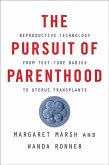Between 1965 and 1987, the cesarean section rate in the United States rose precipitously--from 4.5 percent to 25 percent of births. By 2009, one in three births was by cesarean, a far higher number than the 10% rate that the World Health Organization suggests is optimal. While physicians largely avoided cesareans through the mid-twentieth century, by the early twenty-first century, cesarean section was the most commonly performed surgery in the country. Although the procedure can be life-saving, how--and why--did it become so ubiquitous? Cesarean Section is the first book to chronicle this history. In exploring the creation of the complex social, cultural, economic, and medical factors leading to the surgery's increase, Jacqueline H. Wolf describes obstetricians' reliance on assorted medical technologies that weakened the skills they had traditionally employed to foster vaginal birth. She also reflects on an unsettling malpractice climate--prompted in part by a raft of dubious diagnoses--that helped to legitimize "defensive medicine," and a health care system that ensured cesarean birth would be more lucrative than vaginal birth. In exaggerating the risks of vaginal birth, doctors and patients alike came to view cesareans as normal and, increasingly, as essential. Sweeping change in women's lives beginning in the 1970s cemented this markedly different approach to childbirth. Wolf examines the public health effects of a high cesarean rate and explains how the language of reproductive choice has been used to discourage debate about cesareans and the risks associated with the surgery. Drawing on data from nineteenth- and early twentieth-century obstetric logs to better represent the experience of cesarean surgery for women of all classes and races, as well as interviews with obstetricians who have performed cesareans and women who have given birth by cesarean, Cesarean Section is the definitive history of the use of this surgical procedure and its effects on women's and children's health in the United States. "An outstanding and fascinating contribution to the history of medicine, women's history, and modern social history. Ambitious in its chronological scope, accessibly written, and convincingly argued, Cesarean Section offers new and original insight into the history of childbirth, as well as important broader matters, such as medical power, the technologization of hospitals, and the ethics of modern medical care."--Canadian Bulletin of Medical History "Wolf draws from an impressive array of medical archives, medical literature, popular women's magazines, secondary source material, and her own oral history interviews. The outcome is a monograph that contemplates the complex factors behind the evolution of risk, technology, and birthing. Wolf deftly crafts a narrative that uses the stories of women's recollections of their birthing experience as well as those of physicians as way to reinforce her historical analysis of medical sources and data . . . Cesarean Section will appeal to those interested in women's history and medical history as well as the relationship between culture, risk, and technology."--Bulletin of the History of Medicine
Hinweis: Dieser Artikel kann nur an eine deutsche Lieferadresse ausgeliefert werden.
Hinweis: Dieser Artikel kann nur an eine deutsche Lieferadresse ausgeliefert werden.








